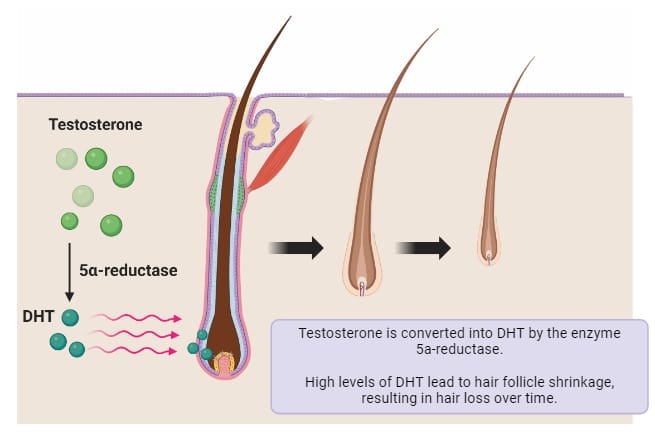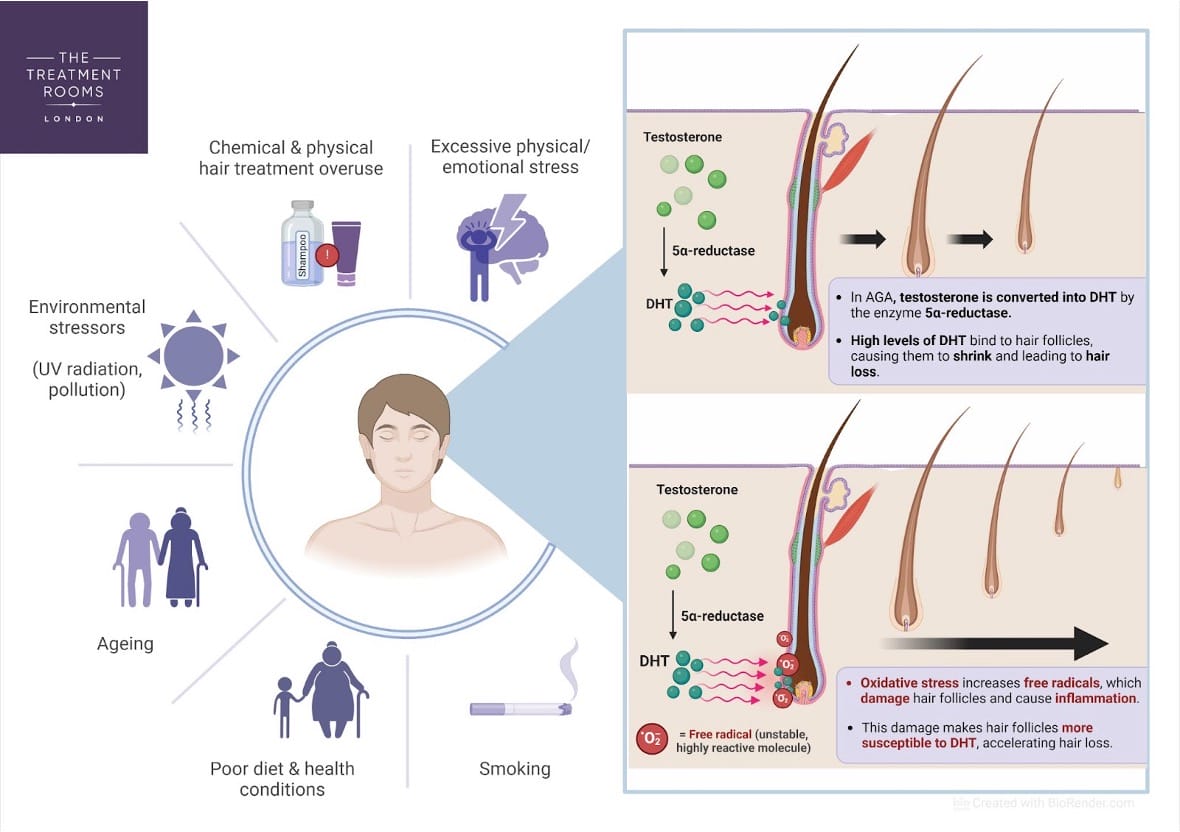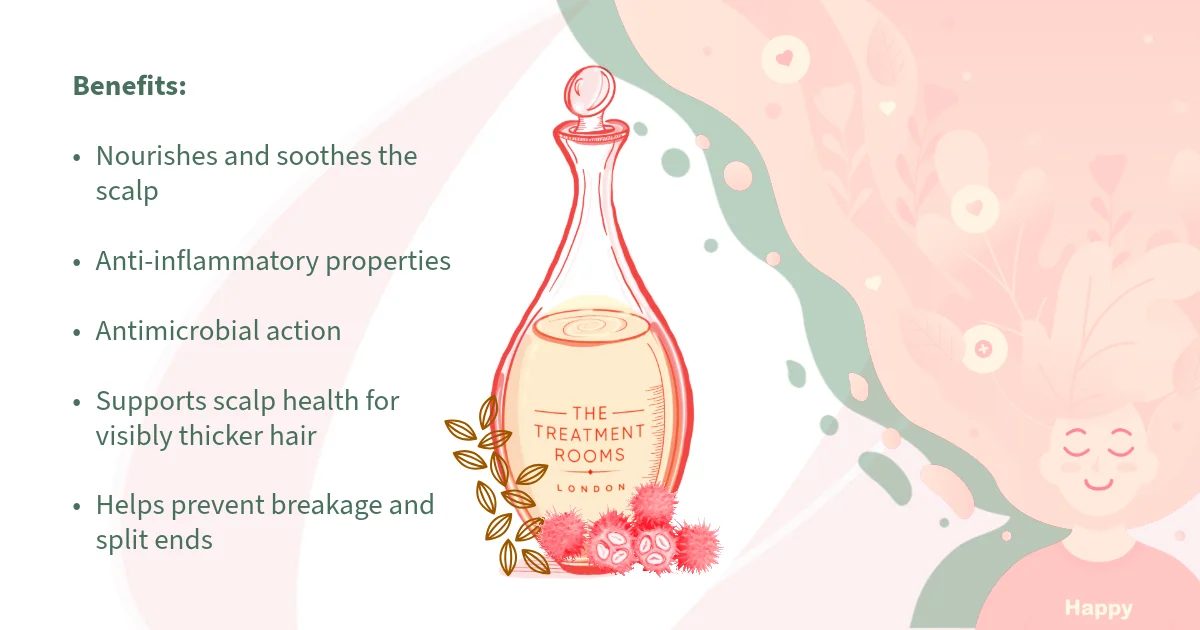Millions of men, women, and teenagers have hair loss problems. In 2025, hair restoration is going through its golden age. However, with advancements in the medical field, the drug and biotech sector, and Radiation treatment, solutions are now becoming increasingly effective, safer, and customised.
This guide focuses on what works in 2025, as well as how to create a personalised treatment plan tailored to your specific needs.
What Are the Main Causes of Hair Loss in 2025?
It is not only because of the ageing process that leads to baldness, but numerous factors come into play. To provide a proper treatment, it is essential to identify the underlying issue.
Is Hair Loss Genetic or Lifestyle-Related?
In hair loss, the genetic factors are also very important. Alopecia (popularly referred to as pattern baldness) is a condition that is related to family inheritance in men and women. Nevertheless, it can be exacerbated by lifestyle factors, such as a poor diet, smoking, and inadequate sleep.

Can Stress or Diet Cause Hair Loss?
Yes. Long-term stress may contribute to the development of an illness called Telogen effluvium, where hair roots are prematurely released into the resting phase. Thinning of the hair may be occurring due to a poor diet in protein, iron, or biotin.
What Hormonal Conditions Contribute to Hair Loss?
Dysfunctions of the hair cycle can be caused by hormonal imbalances, e.g. by thyroid disorders or stomach disorders, by polycystic ovary syndrome (PCOS) or menopause. It is also normal for women to experience some shedding during postpartum conditions.
What Hair Loss Treatments Work in 2025?
Due to the current innovations in the field of dermatology, hair restoration is now a reliable field. All the following recommended treatments have proven to be the most effective, both based on clinical experience and their success among users.
Are There Any New Breakthroughs in Hair Loss Treatment?
Yes. In 2025, significant discoveries are made, and they include:
Exosome therapy: Stem cells can also be effective in promoting follicle growth by releasing exosomes.
Topical finasteride: A potentially less hazardous alternative to drug-intolerant individuals.
WNT signalling regulators: These are a new set of agents still under study, which trigger the signalling of hair growth.
“In 2025, we’re fortunate to have a wide range of effective treatments for hair loss, but the key remains a precise diagnosis. Hair loss is usually a symptom of an underlying issue, which can range from certain lifestyle habits or nutritional deficiencies to broader causes like genetic or autoimmune conditions. Our role as clinicians is to understand the root cause before recommending any course of action. A tailored plan always produces the safest and most sustainable results.”
Dr Dilan Fernando, Director and Hair Transplant Surgeon at Treament Rooms London
What are the best treatments approved by the FDA?
The gold standard two FDA-approved therapies are still there:
Minoxidil (Rogaine): a topical vasodilator, which leads to a rise in the flow of blood on the scalp.
Finasteride (Propecia): This medication inhibits the production of DHT and is currently administered orally to the male population, as well as topically.
Which Treatments Are Backed by Science?
Minoxidil, finasteride, low-level laser therapy (LLLT), PRP therapy and hair transplant are all supported by many clinical studies. The first way is to consult a dermatologist and then start treatment.
What Is the Best Treatment for Male and Female Pattern Baldness?
In men, hair loss can only be best treated using a combination of finasteride and minoxidil.
In women, Minoxidil therapy is initially recommended; the hormonal treatment can prove beneficial depending on the causative factor.
How Do Medical Hair Loss Treatments Compare?
Does Minoxidil work?
Yes. In most users, regrowth is observable within 4 to 6 months. It is available in 2% and 5% concentrations, with men and women responding well to it.
Can Finasteride be used Long-Term?
Yes, it does, especially in men under 40. It reduces the amount of DHT, thereby stunting or halting baldness. Side effects (e.g. depleted sex drive) are reported in less than 2 per cent of users.
What are the risks and benefits of Dutasteride?
Dutasteride is a more effective inhibitor of DHT than finasteride, and it is used off-label. It works very well, but it can be linked to more side effects.
Do Combination Therapies Work?
Absolutely. Inactive products, such as minoxidil, finasteride, microneedling, or PRP, can contribute to significantly better outcomes than monotherapies.
Are Natural Remedies for Hair Loss Effective?
Although medical treatment is often the most effective form of hair loss treatment, the vast majority of people choose natural solutions to address the problem, either as a supplement to their current medical process or as a milder alternative. Are these treatments, however, viable? Ok, let us deconstruct it.
Does Saw Palmetto Help In Hair Regrowth?
It is one of the factors that can naturally suppress DHT, and it is found in many hair loss supplements in abundance. It is, however, less effective than finasteride.
What Vitamins and Supplements Help Hair Loss?
Vitamins and minerals are primary factors in promoting healthy hair growth, particularly in cases of nutritional deficiency. The nutrients that are hair-friendly are:
Biotin (Vitamin B7): Essential for keratin production and commonly found in hair supplements.
Iron: Deficiency of adequate iron (both in women and men) is one of the most significant contributing factors towards diffuse thinning of hair.
Vitamin D deficiency: Vitamin D deficiency is the cause of alopecia areata and all other hair losses.
Zinc: The nutrient enhances the health of the scalp and aids in rebuilding the follicles.
Omega-3 fatty acids: These promote the reduction of inflammation and body nourishment to the hair shaft.
Be sure to keep in mind that supplements will only be effective in cases where you are deficient. In alternative instances,
Greater harm than good can be caused by the uncontrolled consumption that is not controlled with the help of medical guidance.
Do Lifestyle Changes Support Regrowth?
Absolutely. Stress is manageable, a healthy diet can be maintained, and sleep can be improved to have a positive impact on the treatment.
What Are the Best Non-Surgical Treatments in 2025?
Less invasive Non-surgical treatment is a powerful alternative that acts as an alternative to surgery, used by individuals who cannot find it right to undergo surgical intervention techniques, such as hair transplantation, to enhance hair growth and minimise hair loss cases.
Each of the methods has undergone dramatic changes in recent years and currently incorporates advanced technology that is slowly receiving scientific validation.
Is PRP Still an Effective Option?
Yes. PRP therapy applies your blood platelets, which stimulate inactive follicles. Appropriate to mild-moderate hair loss.

Are Laser Caps or Red Light Therapy Useful?
Low-level laser therapy (LLLT) enhances blood flow and stimulates the follicle. The use of laser caps is effective and simpler to use in a personal setting, and has been approved by the FDA.
Can Microneedling Help Regrow Hair?
To further enhance topical treatments, dermarollers or micro-needling pens can be applied to increase penetration and encourage the release of growth factors. Should be used in combination with minoxidil.
What About Surgical Hair Restoration?
In 2025, surgical hair restoration remains the gold standard, particularly for individuals with a high degree of hair loss or seeking a more permanent and dramatic hair restoration solution. With the advancement of technology and the development of more sophisticated techniques, hair transplants have become safer, more effective, and provide more natural-looking results.
Is a Hair Transplant the Most Permanent Solution?
Yes. It entails harvesting of follicles in an area of high density and transferring them to places where the density of follicles is less. The outcomes with proper adjustments are permanent and natural improvements.
In 2025, we’re fortunate to have a wide range of effective treatments for hair loss, but the key remains a precise diagnosis. Hair loss is often a symptom of an underlying issue, which can range from certain lifestyle habits or nutritional deficiencies to more severe causes, such as genetic or autoimmune conditions.
Our role as clinicians is to understand the root cause before recommending any course of action. A tailored plan always produces the safest and most sustainable results.”
What’s the Difference Between FUT and FUE?
As of 2025, there are two major hair transplant procedures: Follicular Unit Transplant (FUT) and Follicular Unit Extraction (FUE).
FUT (Follicular Unit Transplantation): FUT, also known as the strip technique, involves surgically removing a segment of skin containing hair in the form of a thin scalp strip from the donor area. Thereafter, the strip will be disintegrated and inserted separately in the balding regions. The method is likely to generate additional grafts at one time, and in mass transplants, it might be cost-effective. It, however, leaves a straight scar right on the back of your head, which, when you wear your hair short, may be seen.
“We’re now seeing genuine progress in both medical and surgical hair restoration methods, from refined FUE techniques to adjunct treatments like PRP and emerging therapies such as exosomes, all aimed at revitalising weakened hair follicles. These advancements mean we can achieve natural outcomes with less downtime, helping patients regain not just their hair, but their confidence too.”
Dr Roshan Vara, Director and Hair Transplant Surgeon at Treatment Rooms London
FUE (Follicular Unit Extraction): The FUE method is a minimally invasive technique that involves the removal of individual follicular units, one at a time, using a punch tool.
The procedure has more minor, itty-bitty dot scars that can barely be noticed on your face, and the recovery takes place much quicker. It is best suited for those who can commit to having their hair cut to short lengths or for individuals who require a less invasive procedure.
FUE has gained popularity in recent years due to its precision, rapid healing, and minimal scarring, particularly with the introduction of robot-assisted extraction and sapphire blade incisions.
What Hair Loss Treatment Is Best for Women?
The issue of hair loss among women is quite emotionally involved, but in most cases, it is poorly diagnosed. Women also do not typically develop a receding hairline or bald spots, unlike men, who are more prone to diffuse thinning of the hair on the head.

Since patterns and causes of hair loss are diverse, the treatment approach is also varied. Women nowadays have a broader selection to make in 2025 than ever before, and the key point to determine the type of treatment to administer is that the problem is genetic, hormonal or stress-related.
Are Treatments Different for Female Pattern Hair Loss?
Yes. Women tend to experience hair thinning more frequently than men. Minoxidil is the only FDA-approved one, but the hormonal therapy can also be effective.
Can Women Use Minoxidil and Finasteride Safely?
Minoxidil is non-toxic. The oral form of finasteride is not usually given to any woman of childbearing age due to its congenital disabilities. Research is carried out on topical products.
Are There Hormonal Treatments Specifically for Women?
Yes. With the assistance of spironolactone and oral contraceptives, the level of androgens among women suffering from PCOS or hair loss associated with hormones could be normal.
What’s the Best Hair Loss Treatment for Men in 2025?
Male baldness or androgenetic alopecia affects up to 70 per cent of the male population at some stage in their lives. It mostly depends on genes and sensitivity to DHT (Dihydrotestosterone), which causes hair follicles to shrink over time.
Fortunately, by 2025, the world will be equipped with a wide range of treatment techniques that have been proven to slow down, halt, and, in many cases, regrow hair.
They will comprise medical treatment in the form of pills, shampoos, creams, topical care, and injections. Prompt rehabilitation would be best served with a follow-up of a day-to-day treatment.
Can Testosterone or DHT Blockers Help?
Yes. DHT blockers (either finasteride or dutasteride) are also the most successful first-line treatments of male pattern baldness.
What’s the Best Hair Loss Shampoo for Men?
Although shampoos do not cure baldness, applying the right one might help maintain a healthy scalp and complement the effects of other remedies, as well as decrease inflammation or dandruff that can lead to shedding. The leading hair loss shampoos for men in 2025 include ingredients clinically proven, which include:
Ketoconazole, previously used as an antifungal
This has been shown to decrease scalp inflammation and reduce DHT slightly with routine use. It is present in both over-the-counter shampoos and prescription shampoos (e.g., 2% Nizoral) and is frequently used in conjunction with a multi-approach treatment plan.
Caffeine
The use of caffeine as a topical would allow it to enter the skin on the scalp and potentially stimulate the hair follicles. Specific research indicates that it enhances and prolongs hair shafts and postpones the shrinking of the follicles.
Biotin (Vitamin B7)
It is a rare vitamin, but it is found in most shampoos due to its ability to enhance the integrity of the hair shaft and the overall health of the scalp.
Saw Palmetto
It is the most common natural DHT blocker, which appears to be making its way into many hair products for men, serving as a natural alternative to pharmaceuticals.
Salicylic Acid or Zinc Pyrithione
Salicylic acid is suitable for use on men with dandruff or seborrheic dermatitis, which are two conditions that can lead to shedding if left unaddressed.
Apply these shampoos at least 3 to 5 times a week, leaving them on your scalp for 3-5 minutes by gently massaging them into your hair. Then, wash them off to achieve optimal results. They are most effective when used in combination with medical products such as minoxidil or finasteride.
How to Choose the Right Hair Loss Treatment?
By 2025, numerous treatments will be available on the market. It will be available as over-the-counter products, supplements, prescription drugs, as well as laser treatment and surgery. The variety of choices is bound to baffle anyone who has started exploring the matter.
The thing is that there cannot be a universal solution. You are also a mix of personality and diagnosis, so it all depends on what kind of treatment would work well with you.
What Factors Should Guide Your Choice?
The factors to keep in mind concerning hair loss treatment strategy selection are the following:
Cause of Hair Loss
Is your hair loss caused by genetic androgenetic alopecia (family hair loss), hormonal (e.g., PCOS or menopause), stress (telogen effluvium), autoimmune (e.g., alopecia areata), or due to an unexplained nutritional deficiency? The cause should be established since the required treatment depends on the diagnosis.
Gender
Men and women respond differently towards certain drugs. One is the case where finasteride is highly effective in the treatment of men, yet it is not recommended in the treatment of women of childbearing age due to the potential side effects it can have. Hormonal medication, especially spironolactone or contraceptive pills, can only be applied by women.
Age
One of the younger ones has a broader range of options to receive the treatment at the initial stages by means of pills and laser techniques, but the older group can turn to the use of surgical procedures when the hair grows no more.
Budget
Non-surgical options include minoxidil, finasteride, and DHT-shampoo-blocking shampoos, which are practical and affordable for a large number of people. The cost is more financially burdensome and may require continuous maintenance, such as surgery, laser caps, or PRP therapy.
Long-term Dedication
Most hair loss remedies are not simple; they require a lot of tolerance. Minoxidil, finasteride, laser treatment, and microneedling must be used on a long-term basis to maintain the desired outcomes. An alternative to hair transplant surgery could be a viable option.
If you prefer a more permanent solution, this is likely a more effective option; however, it still requires routine hair aftercare and ongoing maintenance of the unwanted areas.
In a nutshell, the best treatment is one that suits your biology, lifestyle, expectations, and ambitions.
Should You Consult a Trichologist or Dermatologist?
Yes. The correct diagnosis should be made to select the most effective and safe treatment.
Hair Loss Treatment FAQs
- Can hair grow back after balding?
This is contingent upon the condition that the follicles are alive. If they become atrophied, a transplant may be the solution.
- What is the most effective treatment for hair loss in the UK?
Minoxidil and finasteride are still the gold standard. PRP and transplants also yield excellent results, depending on the individual case.
- Are there hair loss treatments without side effects?
Less risky, but possibly less effective, are natural alternatives and laser therapy.
- Is it too late to treat hair loss at 40?
No. The terms of early intervention are better, though there are a significant number of effective interventions in the late stages of loss.
- How long does it take for hair treatments to work?
The majority of them show results within 46 months, and these improvements continue for 12 months or more.
Conclusion
The loss of hair is difficult not only to deal with, but a solution is anticipated by 2025. The secret is to examine the cause of it all and compare it with the appropriate cure, which could be medical treatment, natural, or when it calls for intervention. When using any hair loss program, it is advisable to consult a certified dermatologist before taking any action.
Get in Touch
Take the step toward a fuller, more natural-looking hairline: schedule your complimentary consultation with us. We are a leading hair transplant clinic in the UK, with our central operation location in London and a virtual clinic presence across the UK, including Manchester, Birmingham, and Leicester.
Our award-winning team, including leading London hair transplant surgeons Dr Fernando and Dr Vara, is here to support you every step of the way.
References
Olsen, E. A., Dunlap, F. E., Funicella, T., Koperski, J. A., Swinehart, J. M., Tschen, E. H., & Trancik, R. J. (2002). A randomised clinical trial of 5% topical minoxidil versus 2% topical minoxidil and placebo in the treatment of androgenetic alopecia in men. Journal of the American Academy of Dermatology, 47(3), 377–385. https://www.jaad.org/article/S0190-9622(02)00124-X/abstract
Messenger, A. G., & Rundegren, J. (2004). Minoxidil: Mechanisms of action on hair growth. British Journal of Dermatology, 150(2), 186–194. https://academic.oup.com/bjd/article-abstract/150/2/186/6635785?
Mayoclinic https://www.mayoclinic.org/diseases-conditions/hair-loss/diagnosis-treatment/drc-20372932
Share:
Authored by
Reviewed by
Book a Consultation
Related Blogs
What Happens If You Stop Using Minoxidil
November 2, 2025
If you’ve been consistently applying minoxidil to support your hair growth, have you ever wondered what happens…
Unlocking the Secrets of Anagen Follicles
October 23, 2025
Have you ever glanced at a mirror and wondered why some of your hair grows fast and…
Does Finasteride Cause Erectile Dysfunction?
October 22, 2025
Finasteride is one of the most promising medicines against male pattern baldness and benign prostatic hyperplasia (BPH)….
Zinc Supplements After Hair Transplant Surgery: What You Need to Know
October 7, 2025
Zinc is an essential nutrient in wound healing, tissue repair, and the healthy development of hair follicles….
What to Eat After a Hair Transplant: Essential Nutritional Guide
October 5, 2025
After the stress, needles, and surgeries, food becomes more than nourishment. A warm bite, a familiar flavour,…
What is an FUE Hair Transplant?: A Comprehensive Guide to Procedure, Recovery, and Results
October 3, 2025
Hair transplant surgery has gained popularity over the years, with more people now comfortable taking care of…
Does Omega-3 Deficiency Cause Hair Loss? Evidence, Mechanisms & Nutrition Guide
September 16, 2025
Omega is an essential fatty acid required for a healthy body, skin and scalp. Modern-day diets are…
When Can You Use Nizoral After a Hair Transplant?
September 12, 2025
Nizoral is a medicated shampoo that contains the antifungal drug ketoconazole. This shampoo acts against fungal infections…
When Can You Safely Use Oil After a Hair Transplant? Expert Timeline & Tips
September 10, 2025
There is simply something about running your fingers through hair that is healthy and well-nourished. Hair oils…










